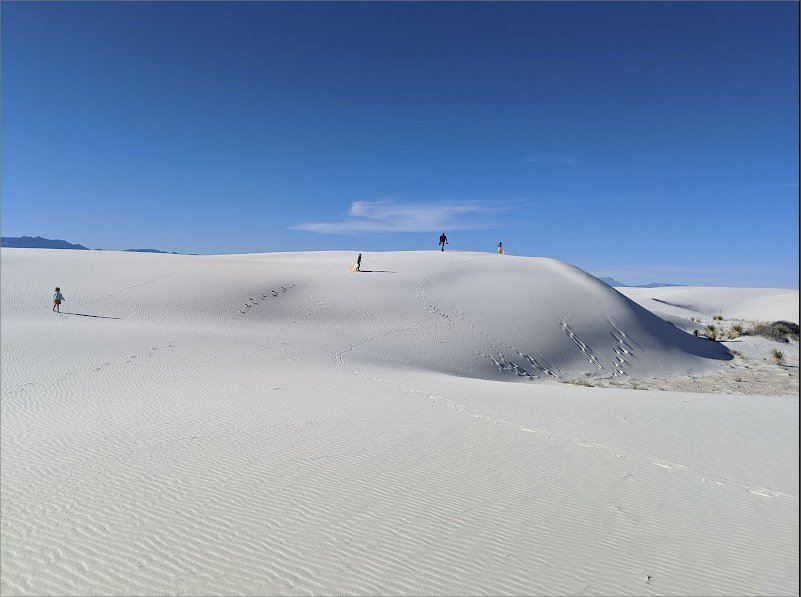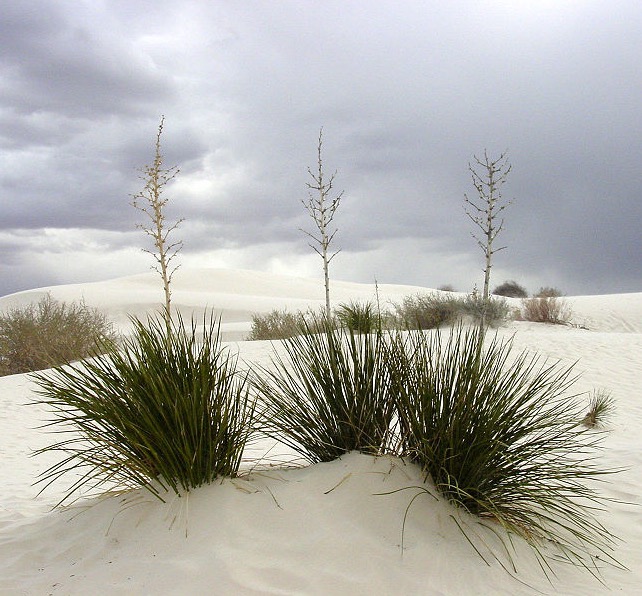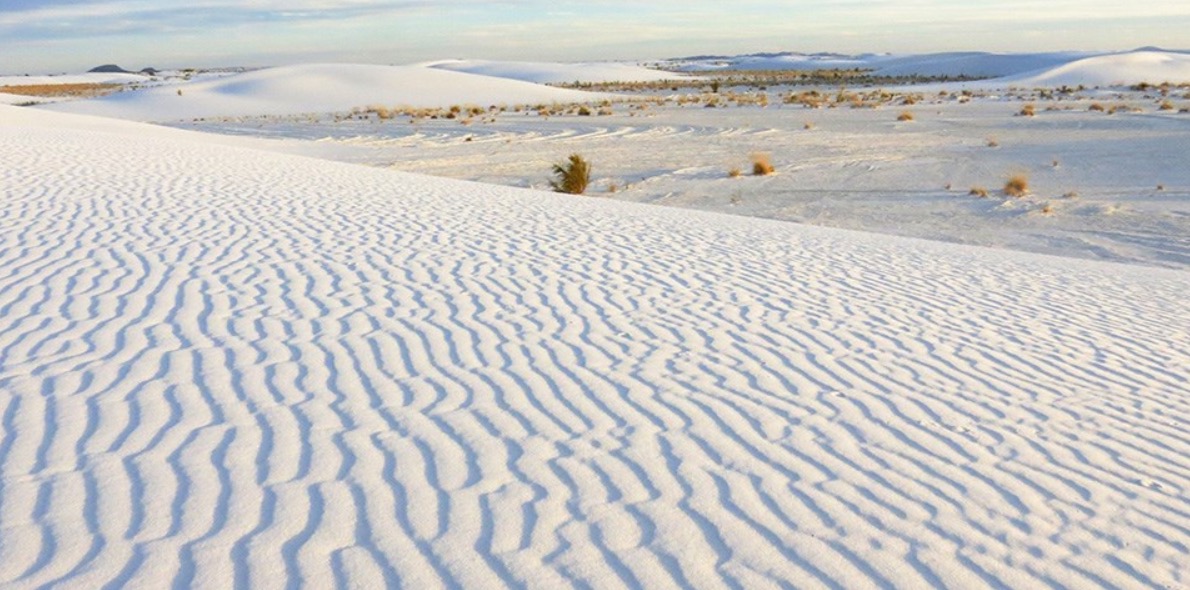Table of Contents
White Sands National Park is a breathtaking destination located in the southern region of New Mexico, United States. Known for its unique white gypsum sand dunes, the park offers a wide range of activities for visitors to explore. Whether you’re interested in hiking, wildlife watching, or stargazing, White Sands National Park has something for everyone.
Exploring the Dunes is one of the most popular activities at White Sands National Park. Visitors can take a leisurely stroll on the dunes, sled down the sandy slopes, or even try their hand at sandboarding. The park offers a variety of rental options for sleds and sandboards, making it easy for visitors to enjoy this exciting activity.

Nature and Wildlife enthusiasts will also find plenty to see and do at White Sands National Park. The park is home to a diverse range of flora and fauna, including rare species such as the white Sands pupfish and the Bleached earless lizard. Guided Tours are available for visitors who want to learn more about the park’s unique ecosystem and the animals that call it home.
Key Takeaways
- White Sands National Park offers a wide range of activities for visitors to explore.
- Exploring the Dunes and Nature and Wildlife watching are popular activities at the park.
- Guided Tours are available for visitors who want to learn more about the park’s unique ecosystem.
Exploring the Dunes
White Sands National Park is home to some of the most unique and beautiful natural landscapes in the world. The park’s gypsum dunes, which cover over 275 square miles, are a must-see for anyone visiting the area. Here are two activities to make the most of your time exploring the dunes:
Sledding Down the Gypsum Dunes
One of the most popular activities at White Sands National Park is sledding down the gypsum dunes. Visitors can rent a plastic sled from the park’s gift shop or bring their own. The best place to sled is in the loop portion of Dunes Drive, away from the road and where there is little or no vegetation. Sledding is a thrilling activity that is sure to be enjoyed by visitors of all ages.
Photography at Sunset
The gypsum dunes at White Sands National Park provide a stunning backdrop for photography, especially at sunset. The changing colors of the sky and the dunes create a unique and beautiful scene that is perfect for capturing memories. Visitors are encouraged to bring their cameras and take advantage of the park’s many photographic opportunities.
Whether sledding down the dunes or capturing the perfect photograph, exploring the gypsum dunes at White Sands National Park is an unforgettable experience that should not be missed.
Nature and Wildlife
When it comes to natural beauty, White Sands National Park has plenty to offer. The park boasts a diverse flora that includes various types of cacti, yuccas, and grasses. Visitors can explore the park’s unique ecosystem by taking a leisurely stroll or a challenging hike along one of the park’s five trails.
Discover the Diverse Flora
One of the most striking features of White Sands National Park is its vast expanse of white gypsum sand dunes. However, the park is also home to a diverse range of plant species that have adapted to the harsh desert environment. The park’s flora includes various types of cacti, yuccas, and grasses. Visitors can learn more about the park’s flora by taking a guided tour or by exploring on their own.

Spotting the Elusive Wildlife
While the park’s flora is certainly impressive, visitors should also keep an eye out for the park’s elusive wildlife. White Sands National Park is home to a variety of creatures, including lizards, snakes, and insects. Visitors may also spot larger animals such as coyotes, foxes, and kit foxes. Birdwatchers will be delighted to know that the park is home to over 300 bird species, including the roadrunner, the burrowing owl, and the golden eagle. Visitors should remember to respect the park’s wildlife and keep a safe distance at all times.
In conclusion, nature and wildlife enthusiasts will find plenty to explore at White Sands National Park. With its diverse flora and elusive wildlife, the park offers a unique and unforgettable experience for visitors of all ages.
Guided Tours
For those who prefer to explore White Sands National Park with a knowledgeable guide, there are a number of guided tours available. These tours offer visitors the opportunity to learn about the park’s unique geology, history, and ecology from a trained expert.
Full Moon Night Programs
One of the most popular guided tours at White Sands National Park is the Full Moon Night Program. During this tour, visitors are led on a hike through the dunes under the light of the full moon. The program provides a unique perspective on the park’s natural beauty and is a great way to experience the dunes after dark. Reservations are required and can be made online or by phone.
Sunset Strolls
Another popular guided tour is the Sunset Stroll. This tour takes visitors on a leisurely walk through the dunes as the sun sets over the horizon. Along the way, a park ranger provides insights into the park’s unique ecology and history. The Sunset Stroll is a great way to experience the park’s beauty in the cooler temperatures of the evening. Reservations are required and can be made online or by phone.
Overall, guided tours are a great way to experience White Sands National Park. They offer visitors the opportunity to learn about the park’s unique features from a trained expert and to experience the park’s natural beauty in a new and exciting way.
Hiking Trails
White Sands National Park offers a variety of hiking trails that allow visitors to explore the unique landscape of the park. Here are some of the best trails to hike in the park:
Alkali Flat Trail
The Alkali Flat Trail is a challenging hike that covers 5 miles of the park’s dunes. The trail takes hikers through the heart of the dune field and offers stunning views of the surrounding mountains. Hikers should be prepared for the challenging terrain and bring plenty of water.
Interdune Boardwalk Trail
The Interdune Boardwalk Trail is an easy, half-mile hike that takes visitors through the park’s dune field. The trail is wheelchair accessible and offers interpretive signs that explain the unique geology and ecology of the area.
Lake Lucero Path
The Lake Lucero Path is a guided hike that takes visitors to the edge of Lake Lucero, a dry lake bed that is a remnant of the ancient Lake Otero. The hike covers 2 miles of flat terrain and offers visitors the opportunity to learn about the park’s geology and ecology.
Playa Trail
The Playa Trail is a short, easy hike that takes visitors to a dry lake bed in the park’s dune field. The trail covers 0.5 miles of flat terrain and offers visitors the opportunity to see the unique plants and animals that call the park home.
Dune Life Nature Trail
The Dune Life Nature Trail is a half-mile hike that takes visitors through the park’s dune field. The trail offers interpretive signs that explain the unique plants and animals that live in the harsh desert environment.
White Sands Backcountry Trail
The White Sands Backcountry Trail is a challenging hike that covers 4.6 miles of the park’s dunes. The trail takes hikers through the heart of the dune field and offers stunning views of the surrounding mountains. Hikers should be prepared for the challenging terrain and bring plenty of water.
Whether you are an experienced hiker or just looking for a leisurely stroll, White Sands National Park has a trail that is perfect for you. Be sure to bring plenty of water, sunscreen, and appropriate footwear, and always practice Leave No Trace principles to help preserve the park’s unique landscape for future generations.
Picnicking Spots
White Sands National Park offers several picnic areas where visitors can enjoy a meal while taking in the stunning views of the park. Here are two of the best picnic spots in the park:
Picnic at Dune Life Nature Trail
The Dune Life Nature Trail is a great place to stop for a picnic. This trail is located near the visitor center and offers several shaded picnic tables where visitors can enjoy a meal. The trail is an easy 1-mile loop that takes visitors through the heart of the dunes. It’s a great way to experience the beauty of the park while taking a break from the sun.
Lunch at Playa Trail
The Playa Trail is another great spot for a picnic. This trail is located near the heart of the park and offers several shaded picnic tables. The trail is an easy 0.5-mile loop that takes visitors through a playa, or dry lake bed. It’s a unique experience that visitors won’t want to miss.
Both of these picnic areas offer stunning views of the park and are a great way to take a break from exploring. Visitors should be sure to pack plenty of water and sunscreen, as the sun can be intense in the park.
Star Gazing
White Sands National Park is one of the best places in the world to stargaze. It has been designated as an International Dark Sky Park, which means that it has minimal light pollution and provides excellent conditions for viewing stars, planets, and other celestial objects.
To make the most of your stargazing experience at White Sands, it is recommended to visit on moonless nights and in fall/winter for clear skies. Ideal spots are 2 miles from the entrance, on high dunes. Bring a red light to preserve night vision and a guide or app for star identification.
The park offers ranger-led stargazing programs, which are a great way to learn about the night sky and the constellations visible in the park. These programs are free and offered on select nights throughout the year. Visitors can also bring their own telescopes and binoculars to observe the night sky.
It is important to note that backcountry camping at the monument is limited to designated sites, which are clustered in a spectacular section of the dune field about 2 miles from the park’s only road. Visitors interested in camping should plan ahead and make reservations in advance.
Overall, White Sands National Park is a must-visit destination for anyone interested in stargazing. With its stunning landscapes and minimal light pollution, it offers an unparalleled stargazing experience that is sure to leave visitors in awe.
Camping Experience
Camping at White Sands National Park is a unique experience that allows visitors to immerse themselves in the beauty of the park. There are several campgrounds available in and around the park. Visitors can choose from primitive backcountry camping, group camping, or RV camping with hookups.
The park offers backcountry camping permits, which allow visitors to camp anywhere in the park’s backcountry. Visitors can obtain these permits from the visitor center. However, visitors must follow certain rules and regulations when camping in the backcountry. For example, visitors must camp at least one mile away from any developed area, and they must pack out all trash and waste.
For those who prefer a more traditional camping experience, there are two campgrounds available in the park: the White Sands Loop Campground and the Sunset Campground. Both of these campgrounds offer tent and RV camping, but only the White Sands Loop Campground has electric hookups. Visitors can make reservations for these campgrounds online or by phone.
It is important to note that camping in the park can be challenging due to the extreme temperatures and the fine gypsum sand. Visitors should be prepared for hot days and cold nights, and they should bring plenty of water and sunscreen. Additionally, visitors should be aware that the sand can get into everything, so it is important to bring appropriate gear and to clean up thoroughly before leaving the park.
Overall, camping at White Sands National Park is a unique and rewarding experience for those who are prepared for the challenges that come with camping in the desert.
Visitor Center Activities
The visitor center at White Sands National Park is the perfect place to start your adventure. Here are some activities to enjoy:
Educational Exhibits
The visitor center features educational exhibits that showcase the unique geology, ecology, and history of the park. Visitors can learn about the formation of the gypsum dunes, the plants and animals that call the dunes home, and the cultural history of the area. The exhibits are interactive and informative, making them engaging for visitors of all ages.
Gift Shop Souvenirs
The White Sands Trading Post gift shop is located inside the visitor center and offers a variety of souvenirs, books, and gifts. Visitors can purchase unique items that highlight the park’s natural beauty and cultural significance. The gift shop has two entrances, one from the visitor center courtyard and the other facing the north parking lot. Don’t forget to stop by and pick up a memento of your visit to White Sands National Park.
Overall, the visitor center at White Sands National Park offers a great introduction to the park and its unique features.
Seasonal Events
White Sands National Park is a year-round destination, but the park offers some unique experiences during certain seasons. Here are a few seasonal events to look out for:
Full Moon Nights
During full moon nights, the park stays open late, allowing visitors to experience the dunes in a whole new light. The park offers ranger-led programs, moonlit walks, and other activities that are only available during these special nights. Visitors can bring their own flashlights or purchase glow sticks at the park store.
Summer Evenings
In the summer, the park extends its hours, allowing visitors to enjoy the cooler temperatures and stunning sunsets. The park offers evening ranger programs, guided sunset walks, and other activities that are only available during the summer months.
Winter Sports
During the winter months, visitors can enjoy sledding down the dunes, a unique experience only available in a few places in the world. The park rents sleds for a small fee, and visitors can spend hours sliding down the powdery white sand.
Wildflower Bloom
In the spring, the park’s desert landscape comes to life with the blooming of wildflowers. Visitors can take guided tours to see the colorful blooms, or simply explore the park’s trails on their own.
No matter what time of year visitors come to White Sands National Park, they are sure to find something unique and memorable to experience.
Frequently Asked Questions
What are the top activities to experience in White Sands National Park?
White Sands National Park offers a variety of activities for visitors to enjoy, including hiking, sledding, stargazing, and camping. The park is known for its stunning white gypsum sand dunes, which offer a unique landscape for visitors to explore. Hiking trails range from easy to moderate difficulty and offer a chance to experience the dunes up close.
When is the best season to visit White Sands National Park for optimal weather conditions?
The best time to visit White Sands National Park is during the fall, winter, and spring months when the weather is mild and the temperatures are cooler. Summer months can be hot and uncomfortable, with temperatures often exceeding 100 degrees Fahrenheit. Visitors should also be aware of the potential for thunderstorms during the summer months, which can create dangerous lightning conditions.
Can you recommend a route for a self-guided tour of White Sands National Park?
For a self-guided tour of White Sands National Park, visitors can start at the visitor center and take the Dunes Drive, a scenic route through the heart of the dunes. Along the way, visitors can stop at several trailheads and picnic areas to explore the dunes on foot. The park also offers a free mobile app with a self-guided tour that provides information about the park’s history, geology, and wildlife.
What are the operating hours for White Sands National Park throughout the year?
The park is open year-round, with varying hours depending on the season. During the summer months, the park is open from 7am to 9pm. During the fall, winter, and spring months, the park is open from 8am to 5pm. Visitors should check the park’s website for current hours of operation and any closures or special events.
How can visitors travel from White Sands National Park to nearby attractions like Carlsbad Caverns?
White Sands National Park is located in southern New Mexico and is within driving distance of several other popular attractions, including Carlsbad Caverns National Park. Visitors can take US-82 east from White Sands National Park to Carlsbad Caverns, which is located approximately 85 miles away. The drive takes approximately 1.5 hours.
What are some photogenic spots in White Sands National Park for photography enthusiasts?
White Sands National Park offers numerous photogenic spots for photography enthusiasts, including the Interdune Boardwalk, which offers a unique perspective of the dunes and the surrounding mountains. The Sunset Stroll is also a popular spot for photographers, offering stunning views of the dunes as the sun sets behind them. Additionally, the park offers several overlooks and picnic areas that provide great views of the dunes and the surrounding landscape.




